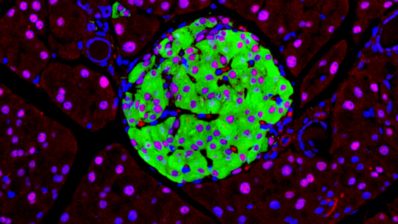90% of cancer-related deaths occur once cells metastasize. Understanding how cells move is crucial to discover new therapeutic targets against this disease. A multidisciplinary and international team involving the Laboratory of Molecular Physiology of the Department of Medicine and Life Sciences, Universitat Pompeu Fabra (MELIS-UPF), has spent six years studying how these cells move and how they adapt to viscosity.
To determine how metastatic cells move, the research team designed bioengineered three-dimensional supports and used high-resolution microscopy to observe their movements and electrical activity. A first study has shown how ion transport allows cancer cells to take water from their anterior part and expel it through the posterior part to propel themselves. And a second investigation has pointed out how, contrary to what one might think, more viscous fluids promote cell migration thanks to changes in the cytoskeleton.
“Tumor cells can move in confined spaces by simply transferring water from the front to the back of the cell”
Miguel Valverde, MELIS-UPF
The research team has observed that the mechanism responsible for producing water propulsion is the ion transport triggered by the sodium/proton transporter NHE1, concentrated at the front of the cell, and the chloride channel SWELL1 located at the back. The NHE1 channel is responsible for promoting an increase in osmotic pressure, which allows water to enter the cell. At the same time, this increase activates SWELL1, which expels the water, causing movement without the need for the cell to establish interactions with the surrounding tissue.
As for viscosity, the team found that when cells detect a viscous medium, they not only respond by modifying the cytoskeleton and motor mechanisms, but can also develop memory to the exposure to this medium. Specifically, high viscosity is detected by the cytoskeleton actin, triggering a molecular response. As a consequence, this activates the TRPV4 channel, which also triggers a series of events that strengthen the cytoskeleton and motor proteins.
This work provides, for the first time, insights into how cancer cells and tumors spread and how they respond to changes in the viscosity of different tissues during metastatic progression. “We believe that the molecules and pathway we identified in our study can be used as drug targets for potential cancer therapies” concludes Miguel Valverde, researcher at MELIS-UPF.
- Yuqi Zhang, Yizeng Li, Keyata N. Thompson, Konstantin Stoletov, Qinling Yuan, Kaustav Bera, Se Jong Lee, Runchen Zhao, Alexander Kiepas, Yao Wang, Panagiotis Mistriotis, Selma A. Serra, John D. Lewis, Miguel A. Valverde, Stuart S. Martin, Sean X. Sun & Konstantinos Konstantopoulos. 2022. Polarized NHE1 and SWELL1 regulate migration direction, efficiency and metastasis. Nature Communications volume 13, Article number: 6128. Doi: 10.1038/s41467-022-33683-1.
- Kaustav Bera, Alex Kiepas, Inês Godet, Yizeng Li, Pranav Mehta, Brent Ifemembi, Colin D. Paul, Anindya Sen, Selma A. Serra, Konstantin Stoletov, Jiaxiang Tao, Gabriel Shatkin, Se Jong Lee, Yuqi Zhang, Adrianna Boen, Panagiotis Mistriotis, Daniele M. Gilkes, John D. Lewis, Chen-Ming Fan, Andrew P. Feinberg, Miguel A. Valverde, Sean X. Sun, Konstantinos Konstantopoulos. 20222. Extracellular fluid viscosity enhances cell migration and cancer dissemination. Nature (2022).







